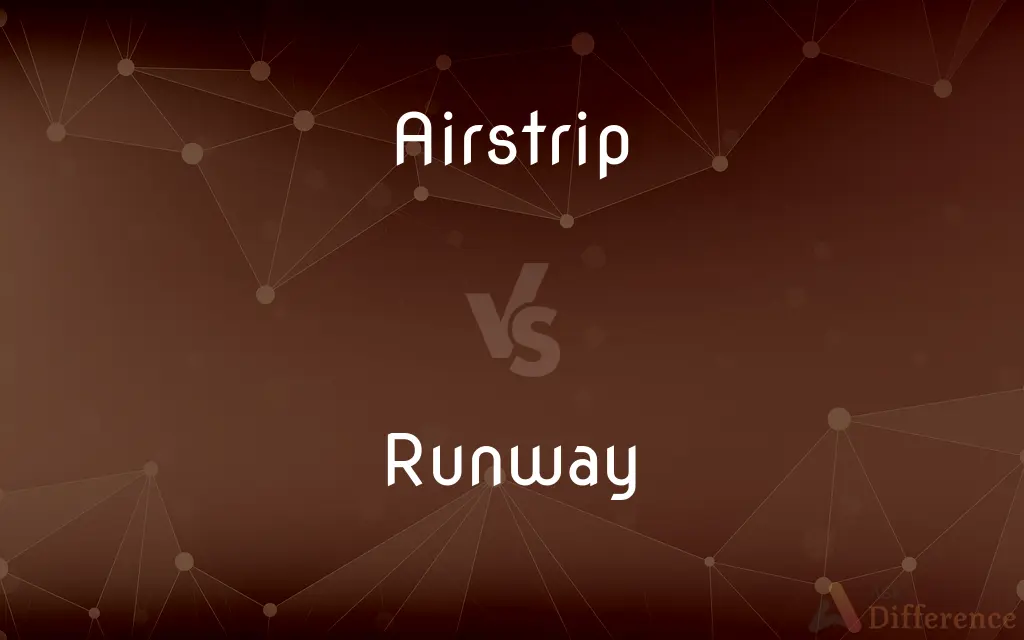Airstrip vs. Runway — What's the Difference?
By Tayyaba Rehman & Fiza Rafique — Updated on March 18, 2024
An airstrip is a small, often unpaved landing area for aircraft, while a runway is a paved, specially prepared path for aircraft takeoffs and landings.

Difference Between Airstrip and Runway
Table of Contents
ADVERTISEMENT
Key Differences
An airstrip typically refers to a simple, basic landing area for aircraft, which can be unpaved or paved but is generally more rudimentary than a runway. It's often found in remote or rural areas, serving small aircraft and private or emergency use. Whereas a runway is a large, paved surface at an airport, designed for the takeoff and landing of commercial and military aircraft, featuring specific markings and lights for navigation and safety.
While airstrips are minimalistic, lacking in extensive facilities or services, runways are part of larger airport complexes, equipped with advanced navigation aids, lighting systems, and safety features. Runways cater to a wide range of aircraft, from small private planes to large commercial jets, and are built to accommodate the heavy traffic and operational requirements of modern aviation.
The location and usage of an airstrip versus a runway also highlight their differences. Airstrips can be located in areas that are inaccessible to larger planes or where a full-fledged airport is not practical, serving as crucial points of access for remote communities. On the other hand, runways are integral components of airports that support both domestic and international flights, facilitating global connectivity.
The construction and maintenance of an airstrip versus a runway reflect their differing roles. Airstrips can be made from grass, dirt, or gravel, requiring minimal upkeep, suitable for light aircraft. In contrast, runways are constructed from concrete or asphalt to withstand the intense impact and wear from frequent, heavy aircraft landings and takeoffs, necessitating regular maintenance and inspection to ensure safety.
Despite these differences, both airstrips and runways are vital for aviation, offering unique functions based on their design, location, and the types of aircraft they accommodate. Airstrips provide essential access to remote areas, while runways serve as the backbone of commercial and military aviation operations.
ADVERTISEMENT
Comparison Chart
Surface
Often unpaved (grass, dirt, gravel)
Paved (asphalt, concrete)
Location
Remote, rural areas
Airports, urban and suburban areas
Usage
Small aircraft, private/emergency use
Commercial and military aircraft, high traffic
Facilities
Minimal
Advanced navigation aids, lighting, safety features
Maintenance
Less frequent, minimal
Regular, extensive
Compare with Definitions
Airstrip
A simple landing strip for aircraft, often unpaved.
The pilot made an emergency landing on a deserted airstrip.
Runway
Equipped with lighting and safety features.
The runway lights guide pilots during night operations.
Airstrip
Can be temporary or permanent.
The military established a temporary airstrip for operations.
Runway
Includes markings for navigation.
The pilot followed the runway markings to align for takeoff.
Airstrip
Used primarily for small planes.
The remote village is accessible by a small airstrip.
Runway
Part of an airport complex.
The runway is undergoing maintenance to improve safety.
Airstrip
Often located in remote or rural areas.
The airstrip in the jungle serves as a lifeline for the indigenous community.
Runway
A paved area for aircraft takeoffs and landings.
The airport's new runway can accommodate larger jets.
Airstrip
Minimalistic in design and facilities.
The airstrip had no lighting, making night landings challenging.
Runway
Designed for heavy aircraft use.
The runway's reinforced concrete withstands the impact of commercial landings.
Airstrip
An aircraft runway without airport facilities.
Runway
According to the International Civil Aviation Organization (ICAO), a runway is a "defined rectangular area on a land aerodrome prepared for the landing and takeoff of aircraft". Runways may be a man-made surface (often asphalt, concrete, or a mixture of both) or a natural surface (grass, dirt, gravel, ice, sand or salt).
Airstrip
An aircraft landing field, usually with one runway and only basic facilities.
The outfitter deposited us at a small airstrip out in the bush, promising to pick us up again in a week's time.
Runway
A strip of level, usually paved ground on which aircraft take off and land.
Airstrip
An airfield without normal airport facilities.
Runway
A path, channel, or track over which something runs.
Airstrip
An airfield without normal airport facilities
Runway
The channel of a stream.
Runway
A chute down which logs are skidded.
Runway
A narrow track in a bowling lane on which balls are returned after they are bowled.
Runway
A smooth ramp for wheeled vehicles.
Runway
A narrow walkway extending from a stage into an auditorium.
Runway
A defined, narrow section of land or an artificial structure used for access.
Runway
The usual path taken by deer or other wild animals, such as from a forest to a water source.
Runway
A narrow walkway (often on a platform) extending from a stage on which people walk, especially one used by models during fashion shows.
Runway
(athletics) In javelin, long jump, and similar events: a short track along which athletes can accelerate themselves for their jumps or throws.
Runway
(aviation) A section of land, usually paved, for airplanes to land on or take off from.
Runway
Hence, the number of months that a startup company can operate by using up its cash reserves.
Runway
A stream bed.
Runway
The channel of a stream.
Runway
The beaten path made by deer or other animals in passing to and from their feeding grounds.
Runway
A narrow platform extending from the stage into the audience in a theater or nightclub etc.
Runway
A strip of level paved surface where planes can take off and land
Common Curiosities
Are airstrips always located in remote areas?
While often found in remote or rural areas, airstrips can also be located near urban centers, serving private or emergency aviation needs.
How is a runway different from an airstrip?
A runway is a paved, well-equipped path at an airport for the takeoff and landing of a wide range of aircraft, including commercial and military flights, featuring advanced safety and navigation aids.
Why are runways paved?
Runways are paved to provide a durable, smooth surface that can withstand the heavy impact and wear from frequent aircraft takeoffs and landings.
What defines an airstrip?
An airstrip is a basic, often unpaved landing area for aircraft, primarily serving small, private, or emergency flights.
What maintenance does a runway require?
Runway maintenance includes regular inspections, repaving, painting of markings, and checking of lighting and safety systems to ensure optimal operation.
Can any aircraft land on an airstrip?
Not all aircraft can land on an airstrip, especially if it's unpaved; suitability depends on the aircraft's design and the airstrip's condition.
Can drones use airstrips and runways?
Drones can use airstrips and runways for takeoff and landing, depending on their size and the regulations of the facility.
How do pilots navigate on runways?
Pilots use runway markings, lights, and navigation aids like the Instrument Landing System (ILS) to align, take off, and land safely.
How do environmental concerns affect airstrip and runway construction?
Environmental concerns can affect construction and operation, with efforts made to minimize impact on local ecosystems and noise pollution.
Can an airstrip become a runway?
Yes, an airstrip can be upgraded to a runway if it's paved and equipped with necessary navigation and safety features to accommodate larger aircraft and increased traffic.
Do airstrips have air traffic control?
Most airstrips do not have air traffic control, relying instead on pilots' communication and coordination for takeoffs and landings.
What future developments are expected in airstrip and runway design?
Future developments may include more sustainable materials, advanced navigation technologies, and designs accommodating new types of aircraft, like electric planes and vertical takeoff and landing (VTOL) vehicles.
What role do airstrips play in emergency situations?
Airstrips can be crucial in emergency situations, providing landing options for medical evacuations, disaster relief, and other urgent needs in inaccessible areas.
What safety measures are in place on runways?
Runway safety measures include lighting systems, runway end safety areas (RESA), and grooved surfaces to reduce water accumulation and increase traction.
How do weather conditions affect airstrip and runway operations?
Weather conditions, such as fog, rain, and snow, can severely affect operations, with runways often equipped with better facilities to handle adverse weather.
Share Your Discovery

Previous Comparison
Camel vs. Fish
Next Comparison
Discard vs. DisregardAuthor Spotlight
Written by
Tayyaba RehmanTayyaba Rehman is a distinguished writer, currently serving as a primary contributor to askdifference.com. As a researcher in semantics and etymology, Tayyaba's passion for the complexity of languages and their distinctions has found a perfect home on the platform. Tayyaba delves into the intricacies of language, distinguishing between commonly confused words and phrases, thereby providing clarity for readers worldwide.
Co-written by
Fiza RafiqueFiza Rafique is a skilled content writer at AskDifference.com, where she meticulously refines and enhances written pieces. Drawing from her vast editorial expertise, Fiza ensures clarity, accuracy, and precision in every article. Passionate about language, she continually seeks to elevate the quality of content for readers worldwide.















































